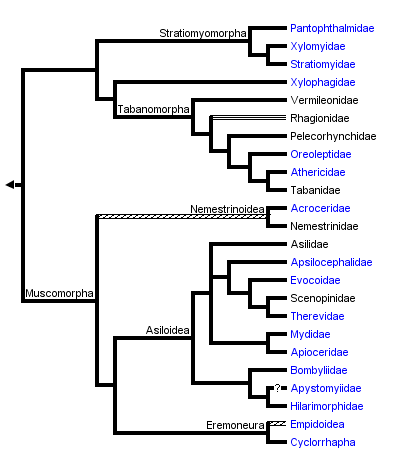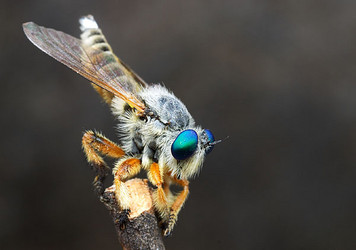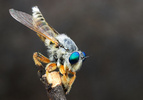Brachycera
Brian M. Wiegmann and David K. Yeates


This tree diagram shows the relationships between several groups of organisms.
The root of the current tree connects the organisms featured in this tree to their containing group and the rest of the Tree of Life. The basal branching point in the tree represents the ancestor of the other groups in the tree. This ancestor diversified over time into several descendent subgroups, which are represented as internal nodes and terminal taxa to the right.

You can click on the root to travel down the Tree of Life all the way to the root of all Life, and you can click on the names of descendent subgroups to travel up the Tree of Life all the way to individual species.
For more information on ToL tree formatting, please see Interpreting the Tree or Classification. To learn more about phylogenetic trees, please visit our Phylogenetic Biology pages.
close boxIntroduction
The suborder Brachycera represents a major division of the Diptera containing approximately 120 families and a great diversity of species, morphological innovations, and life history strategies. The name "Brachycera" or "shortened horn" refers to their shortened antennae—a reduced antenna with fewer than 8 antennal flagellomeres is the easiest to recognise of a list of defining features (see below). The origins of the Brachycera can be traced to the late Triassic or earliest Jurassic (245-208 mya) based on fossil evidence (Evenhuis 1995; Grimaldi and Cumming 1999; Yeates and Wiegmann 1999) and comparisons of evolutionary rates in DNA sequences (Wiegmann et al. 2003).
Characteristics
Brachycera is well supported monophyletic lineage supported by a number of morphological synapomorphies (Yeates 2002; Yeates and Wiegmann 1999; Sinclair et al. 1993; Woodley 1989):
- reduction of antennal flagellomeres to 8 or fewer
- posterior portions of larval head capsule elongated into prothorax
- maxillary palpus with 2 segments or fewer
- wing veins CuA2 and A1 with apices approximate, forming a nearly closed cell Cup
- larval mandible subdivided into distinct two parts
- premandibles lost from ventral surface of labrum
- epandrium and hypandrium of male genitalia separated.
Brachyceran flies exhibit a broad array of feeding strategies, life histories and behavioral patterns. Many of the orthorrhaphous lineages are scavengers, predators or parasitoids as larvae. Multiple major radiations of species diversity, feeding habits and habitat specialization can be found in the Cyclorrhapha or "higher" flies.
Discussion of Phylogenetic Relationships
Traditional non-phylogenetic classifications of the brachycera break the group into two major sections, the 'Orthorrhapha' and Cyclorrhapha. The 'Orthorrhaphous' Brachycera is a paraphyletic assemblage of all those families not included in the Cyclorrhapha. Recent classifications based on explicit phylogenetic evidence include 4 monophyletic infraorders: Stratiomyomorpha, Xylophagomorpha, Tabanomorpha, and Muscomorpha.
Brachyceran phylogeny has been the subject of intensive study in recent years. Comprehensive phylogenetic treatments in Hennig (1973), Griffiths (1972), Woodley (1989) and Sinclair et al. (1994) began the explicit definition of clades based on synapomorphic character states (see Yeates and Wiegmann 1999 for a review). Quantitative phylogenetic analyses of morphological (Yeates 1994, 2002; Yeates et al. 2003; Meier and Hilger 2000) and gene sequence data (Wiegmann et al. 2000, Wiegmann et al. 2003; Collins and Wiegmann 2001ab; Moulton and Wiegmann 2004) continue to add resolution and support to many of the key lineages of brachyceran flies.
References
Collins, K. P. and B. M. Wiegmann. 2002. Phylogenetic relationships and placement of the Empidoidea (Diptera: Brachycera) based on 28S rDNA and EF-1a sequences. Insect Syst. Evol. 33: 21-444.
Griffiths, G. C. D. 1972. The phylogenetic classification of Diptera Cyclorrhapha, with special reference to the male postabdomen. Series entomologica 8, 340pp. The Hague.
Griffiths, G. C. D. 1994. Relationships among the major subgroups of Brachycera (Diptera): A critical review. Can. Entomol. 126:861-880.
Hennig, W. 1973. Diptera. In: W. Kukenthal (ed.) Handbuch der Zoologie, IV: Arthropoda. de Gruyter, New York, pp. 1-337.
Krivosheina, N. P. 1991. Phylogeny of lower Brachycera (Diptera): A new view. Acta Entomol. Bohemoslov. 88:81-92.
McAlpine, J. F., B. V. Peterson, G. E. Shewell, H. J. Teskey, J. R. Vockeroth, and D. M. Wood (eds.). 1981, 1987. Manual of Nearctic Diptera, Vol. 1 & 2. Research Branch, Agriculture Canada, Monographs 27 & 28.
McAlpine, J. F. and D. M. Wood (eds.). Manual of Nearctic Diptera, Vol. 3. Research Branch, Agriculture Canada, Monograph 32.
Moulton, J. K. and B. M. Wiegmann. 2004. Evolution and phylogenetic utility of CAD (rudimentary) among Mesozoic-aged Eremoneuran Diptera (Insecta). Mol. Phylogenet. Evol. 31: 363-378.
Nagatomi, A. 1991. History of some families of Diptera, chiefly those of the lower Brachycera (Insecta: Diptera). Bull. Biog. Soc. Japan 46(1-22): 21-38.
Nagatomi, A. and N. Liu. 1994. Apystomyiidae, a new family of Asiloidea (Diptera). Acta Zool. Hung. 40:203-218.
Sinclair, B. J. 1992. A phylogenetic interpretation of the Brachycera (Diptera) based on the larval mandible and associated mouthpart structures. Syst. Entomol. 17:233-252.
Sinclair, B. J., Cumming, J. M. and D. M. Wood. 1994. Homology and phylogenetic implications of the male genitalia in Diptera-Lower Brachycera. Entomol. Scand. 24:407-432.
Wada, S. 1991. Morphological evidence for the direct sister group relationship between the Schizophora and the Syrphoidea (Aschiza) in the phylogenetic systematics of the Cyclorrhapha (Diptera: Brachycera). J. Nat. Hist. 25:1531-1570.
Wiegmann, B. M., C. Mitter, and F. C. Thompson. 1993. Evolutionary origin of the Cyclorrhapha (Diptera): tests of alternative morphological hypotheses. Cladistics, 9:41-81.
Wiegmann, B. M., D. K. Yeates, J. L. Thorne, and H. Kishino. 2003. Time flies, a new molecular time-scale for brachyceran fly evolution without a clock. Syst. Biol. 52:745-756.
Woodley, N. E. 1989. Phylogeny and classification of the "Orthorrhaphous" Brachycera. In: McAlpine J.F., Wood D.M. (eds.)Manual of Nearctic Diptera 3. Research Branch, Agriculture Canada, Monograph 32:1371-1395.
Yeates, D. K. 1994. The cladistics and classification of the Bombyliidae (Diptera: Asiloidea). Bull. Am. Mus. Nat. Hist. 219:1-191.
Yeates, D. K. 2002. Relationships of the lower Brachycera (Diptera): A quantitative synthesis of morphological characters. Zool. Scripta 31:105-121.
Yeates, D. K. and B. M. Wiegmann. 1999. Congruence and controversy: Toward a higher-level phylogeny of Diptera. Ann. Rev. Entomol. 44:397-428.
Yeates, D. K., M. E. Irwin, and B. M. Wiegmann. 2003. Ocoidae, a new family of asiloid flies (Diptera: Brachycera: Asiloidea), based on Ocoa chilensis gen. and sp. nov. from Chile, South America. Syst. Entomol. 28:417-431.
Yeates, D. K., R. Meier, and B. M. Wiegmann. 2003. Phylogeny of true flies (Diptera): A 250 million year old success story in terrestrial diversification. Entomol. Abh. 61:119.
Zaitsev, V. F. 1991. On the phylogeny and systematics of the dipteran superfamily Bombylioidea (Diptera). Entomologicheskoe Obozrenie 70(3): 716-736.
Zloty, J., B. J. Sinclair, & G. Pritchard. 2005. Discovered in our backyard: a new genus and species of a new family from the Rocky Mountains of North America (Diptera, Tabanomorpha). Systematic Entomology. 30:248-266.
Title Illustrations

| Scientific Name | Asilidae |
|---|---|
| Location | New Mexico, USA |
| Specimen Condition | Live Specimen |
| Identified By | Alex Wild |
| Life Cycle Stage | Adult |
| Copyright |
© 2005 Alex Wild

|
About This Page
Brian M. Wiegmann

North Carolina State University, Raleigh, North Carolina, USA

CSIRO Division of Entomology, Canberra, Australia
Correspondence regarding this page should be directed to Brian M. Wiegmann at and David K. Yeates at
Page copyright © 2004 Brian M. Wiegmann and
All Rights Reserved.
- Content changed 29 November 2007
Citing this page:
Wiegmann, Brian M. and David K. Yeates. 2007. Brachycera. Version 29 November 2007 (under construction). http://tolweb.org/Brachycera/10500/2007.11.29 in The Tree of Life Web Project, http://tolweb.org/









 Go to quick links
Go to quick search
Go to navigation for this section of the ToL site
Go to detailed links for the ToL site
Go to quick links
Go to quick search
Go to navigation for this section of the ToL site
Go to detailed links for the ToL site